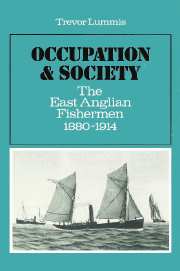Book contents
- Frontmatter
- Contents
- List of figures and tables
- Acknowledgements
- Map
- Introduction
- PART ONE OCCUPATIONAL STRUCTURE
- Introduction
- 1 Inshore
- 2 Trawling
- 3 Drifting
- 4 Working relationships
- PART TWO THE SOCIAL STRUCTURE
- PART THREE THE FAMILY, SOCIAL PRACTICE AND BELIEF
- Appendix: supplementary information on the interviews
- Glossary
- Notes
- Bibliography and sources
- Index
- Frontmatter
- Contents
- List of figures and tables
- Acknowledgements
- Map
- Introduction
- PART ONE OCCUPATIONAL STRUCTURE
- Introduction
- 1 Inshore
- 2 Trawling
- 3 Drifting
- 4 Working relationships
- PART TWO THE SOCIAL STRUCTURE
- PART THREE THE FAMILY, SOCIAL PRACTICE AND BELIEF
- Appendix: supplementary information on the interviews
- Glossary
- Notes
- Bibliography and sources
- Index
Summary
Method, location and development
The real rise of the trawl industry at Lowestoft commenced about the year 1860. At that period there would be about a dozen to twenty vessels, with a tonnage averaging from twenty-five to thirty tons. At that time ice was scarcely introduced into the fishing industry, and the vessels worked more at home on what is known as the Lowestoft Flats, where they caught a large quantity of soles. Shortly after 1860 some of the men who had migrated from Brixham to Ramsgate, commenced coming to Lowestoft with their fish, and eventually made Lowestoft their home, and this laid the foundation of the enormous trawling business now carried on at Lowestoft.
Mr Hame, witness to the Select Committee on Sea Fisheries 1893–4, Vol. XIHistorically the method of trawling was very little used; until the early part of the nineteenth century it was found only in the Thames and at Brixham. The beam trawl consisted of a stout wooden beam which was attached to the top front edge of a long roughly triangular net. On each end of the beam there was a trawl-head, a thick iron hoop which kept the beam clear of the seabed while sliding along like a sledge: in this manner the top of the net was held open and over the seabed.
- Type
- Chapter
- Information
- Occupation and SocietyThe East Anglian Fishermen 1880-1914, pp. 18 - 35Publisher: Cambridge University PressPrint publication year: 1985



